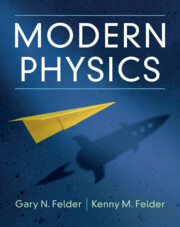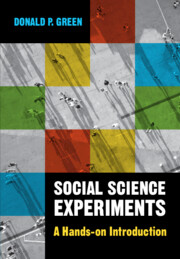Refine search
Actions for selected content:
36901 results in Cambridge Textbooks
Brief Contents
-
- Book:
- Quantum Mechanics
- Published online:
- 11 February 2023
- Print publication:
- 15 September 2022, pp v-vi
-
- Chapter
- Export citation
Appendix A - A Chronology of Modern Physics
-
- Book:
- Modern Physics
- Published online:
- 09 September 2022
- Print publication:
- 15 September 2022, pp 708-708
-
- Chapter
- Export citation
1 - Relativity I: Time, Space, and Motion
-
- Book:
- Modern Physics
- Published online:
- 09 September 2022
- Print publication:
- 15 September 2022, pp 1-52
-
- Chapter
- Export citation
Appendix D - The Electromagnetic Spectrum
-
- Book:
- Modern Physics
- Published online:
- 09 September 2022
- Print publication:
- 15 September 2022, pp 713-714
-
- Chapter
- Export citation
Preface
-
- Book:
- Modern Physics
- Published online:
- 09 September 2022
- Print publication:
- 15 September 2022, pp ix-xvi
-
- Chapter
- Export citation
Copyright page
-
- Book:
- Modern Physics
- Published online:
- 09 September 2022
- Print publication:
- 15 September 2022, pp iv-iv
-
- Chapter
- Export citation
2 - Relativity II: Dynamics
-
- Book:
- Modern Physics
- Published online:
- 09 September 2022
- Print publication:
- 15 September 2022, pp 53-106
-
- Chapter
- Export citation
14 - Cosmology
-
- Book:
- Modern Physics
- Published online:
- 09 September 2022
- Print publication:
- 15 September 2022, pp 646-707
-
- Chapter
- Export citation
Useful Definitions and Equations
-
- Book:
- Quantum Mechanics
- Published online:
- 11 February 2023
- Print publication:
- 15 September 2022, pp xxiii-xxiv
-
- Chapter
- Export citation
5 - The Schrödinger Equation
-
- Book:
- Modern Physics
- Published online:
- 09 September 2022
- Print publication:
- 15 September 2022, pp 213-259
-
- Chapter
- Export citation
Index
-
- Book:
- Modern Physics
- Published online:
- 09 September 2022
- Print publication:
- 15 September 2022, pp 730-738
-
- Chapter
- Export citation
8 - Hydrogen Atom
-
- Book:
- Quantum Mechanics
- Published online:
- 11 February 2023
- Print publication:
- 15 September 2022, pp 250-274
-
- Chapter
- Export citation
4 - The Quantum Revolution II: Matter and Wavefunctions
-
- Book:
- Modern Physics
- Published online:
- 09 September 2022
- Print publication:
- 15 September 2022, pp 172-212
-
- Chapter
- Export citation
Contents
-
- Book:
- Quantum Mechanics
- Published online:
- 11 February 2023
- Print publication:
- 15 September 2022, pp vii-xiv
-
- Chapter
- Export citation
12 - The Atomic Nucleus
-
- Book:
- Modern Physics
- Published online:
- 09 September 2022
- Print publication:
- 15 September 2022, pp 556-595
-
- Chapter
- Export citation
Appendix G - Physical Constants
-
- Book:
- Quantum Mechanics
- Published online:
- 11 February 2023
- Print publication:
- 15 September 2022, pp 551-552
-
- Chapter
- Export citation
3 - The Quantum Revolution I: From Light Waves to Photons
-
- Book:
- Modern Physics
- Published online:
- 09 September 2022
- Print publication:
- 15 September 2022, pp 107-171
-
- Chapter
- Export citation
Appendix C - Quantum Mechanics Equations
-
- Book:
- Modern Physics
- Published online:
- 09 September 2022
- Print publication:
- 15 September 2022, pp 710-712
-
- Chapter
- Export citation

Modern Physics
-
- Published online:
- 09 September 2022
- Print publication:
- 15 September 2022
-
- Textbook
- Export citation

Social Science Experiments
- A Hands-on Introduction
-
- Published online:
- 08 September 2022
- Print publication:
- 29 September 2022
-
- Textbook
- Export citation
